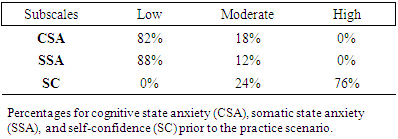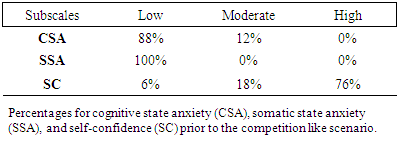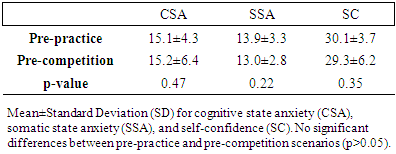-
Paper Information
- Paper Submission
-
Journal Information
- About This Journal
- Editorial Board
- Current Issue
- Archive
- Author Guidelines
- Contact Us
International Journal of Sports Science
p-ISSN: 2169-8759 e-ISSN: 2169-8791
2020; 10(5): 117-122
doi:10.5923/j.sports.20201005.04
Received: Sep. 28, 2020; Accepted: Oct. 16, 2020; Published: Oct. 26, 2020

Levels of Anxiety: Practice vs. Competition among NCAA Division I Women Gymnasts
Kirsten Yee, Abigail Larson, Mark DeBeliso
Department of Kinesiology and Outdoor Recreation, Southern Utah University, Cedar City, UT, USA
Correspondence to: Mark DeBeliso, Department of Kinesiology and Outdoor Recreation, Southern Utah University, Cedar City, UT, USA.
| Email: |  |
Copyright © 2020 The Author(s). Published by Scientific & Academic Publishing.
This work is licensed under the Creative Commons Attribution International License (CC BY).
http://creativecommons.org/licenses/by/4.0/

Prior to competition somatic and cognitive state anxiety levels can increase leading to a decrease in performance and increase in injury risk. Identifying situations that could cause high levels of anxiety are important so proper anxiety management techniques can be used. PURPOSE: The purpose of this study was to compare levels of somatic and cognitive anxiety as well as self-confidence in collegiate gymnasts prior to a pre-practice and pre-competition like scenario. METHODS: One NCAA Division I Gymnastics Team (n=17) completed the Competitive State Anxiety Inventory-2 (CSAI-2) survey prior to a practice and again prior to a competition setting. The CSAI-2 contains three subscales (cognitive anxiety, somatic anxiety, and self-confidence). The CSAI-2 subscale scores were compared between the pre-practice and the pre-competition scenarios with paired t-tests (α<0.05). RESULTS: No statistical differences in the subscale scores (cognitive anxiety, somatic anxiety, and self-confidence) were found between the practice and the competition scenarios (p>0.05). CONCLUSIONS: Within the parameters of this study, anxiety and self-confidence levels appear consistent between practice and competitive scenarios among collegiate gymnasts.
Keywords: CSAI-2, Women gymnastics, Performance anxiety, Pre-practice, Pre-competition
Cite this paper: Kirsten Yee, Abigail Larson, Mark DeBeliso, Levels of Anxiety: Practice vs. Competition among NCAA Division I Women Gymnasts, International Journal of Sports Science, Vol. 10 No. 5, 2020, pp. 117-122. doi: 10.5923/j.sports.20201005.04.
1. Introduction
- Anxiety is defined as an emotion that is felt when facing uncertain threats and is considered to be one of the most important psychological determinants of sport performance [5,9]. Anxiety is multidimensional by nature and may manifest as somatic anxiety and/or cognitive anxiety [5]. Cognitive anxiety refers to an athlete’s mental thoughts or concerns about the performance or competition [3]. Somatic anxiety refers to common physical symptoms of anxiety including increased heart rate, sweating, uncontrolled muscular tension, shaky hands, butterflies in the stomach, and/or rapid breathing [6,13,18]. Somatic and cognitive anxiety can be further classified as a state or trait [5]. State anxiety is an emotional state that is felt acutely and is characterized by apprehension, fear, and increased physiological arousal [5]. Trait anxiety refers to a predisposition to where an individual feels threatened and responds with increased state anxiety [5].Somatic and cognitive anxiety can significantly impact the performance level of athletes on competition day [5,10]. The multidimensional anxiety theory helps in understanding the relationship between anxiety and performance. It states there is a negative linear relationship with cognitive anxiety and performance, as well as, an inverted-U relationship with somatic anxiety and performance [5]. Meaning, any amount of cognitive anxiety has the potential to impair performance while low levels of somatic anxiety can result in underperformance and moderate levels of somatic anxiety can result in ideal performance, but high levels of somatic anxiety can result in underperformance. Importantly, self-confidence (SC), defined as one’s feeling of trust in their ability to have a successful performance, is inversely related to cognitive and somatic state anxiety [2,5].
 | Figure 1. NCAA Women’s Gymnastics (courtesy of K. Navalta) |
2. Methods
- ParticipantsThe participants in this study were competitive female gymnasts from a NCAA Division I Women’s gymnastics team. Only gymnasts that were competing on one or more apparatuses were permitted to participate in this study. The gymnasts ranged in age from 18 to 22 years old (n=17). The study was conducted during the pre-season, temporally near the annual Red and White preview (an intra-squad competition).After IRB approval (SUU IRB approval # 27-092019a), participants were given a written informed consent form that explained the study purpose and procedures. Participants who agreed to participate completed an informed consent prior to filling out the questionnaire. No compensation was provided for participating in the study. InstrumentThe CSAI-2 questionnaire was used for this study. It includes 27 questions that assesses state anxiety in the dimensions of CSA, SSA, and SC. Each question was answered using a Likert-like scale that ranges from 1 (not at all) to 4 (very much so). All three subscales were calculated according to Martens, Vealey, and Burton [13]. After each questionnaire was calculated, the subscale scores were characterized as follows: 9 to 18 points low levels of anxiety or SC, 19 to 27 points moderate levels of anxiety or SC, and 28 to 36 points high levels of anxiety or SC [2]. The CSAI-2 has demonstrated an internal consistency across subscales of r=0.79-0.94 [11,13] and a test-retest reliability ICC=0.79-0.94 across subscales [16].ProceduresThe CSAI-2 survey was administered twice to the same athletes on two separate occasions, once prior to a practice and again prior to a competition like scenario. In both occasions, upon arriving in the locker room, the surveys (CSAI-2) and pens were provided to the gymnasts. During the first occasion, the gymnasts completed the CSAI-2 while preparing for a practice. After all surveys were completed and collected, each was scored. The scores of the subscales were then classified as previously described.The CSAI-2 was then administered again approximately three weeks following the first administration. The same procedures were employed with the exception being that the CSAI-2 was completed just prior to a competition like scenario. Once again, the completed CSAI-2 surveys were scored and the subscales classified as during the first administration.EnvironmentThe two scenarios that were used in this study were a practice and a competition like scenario. The first scenario was a familiar practice that had been conducted numerous times throughout pre-season. This practice was a non-competitive environment that focused on showing individual skills in front of a crowd. The competition-like scenario was a normal pre-season competition, where the team warmed up on each event, changed into competition attire, and went back to each event for competition using the home meet rotation and a 4 minute touch warm-up. The assistant coaches and head coach judged all 6 routines on all 4 events. The competition followed all standard rules for gymnastics.Statistical AnalysisThe dependent variables in the current study were: CSA, SSA, and SC as assessed by the subscales of the CSAI-2. The independent variable in the current study was environment (pre-practice and pre-competition). The dependent variables were compared between the two environmental conditions with one-tailed dependent t-tests. Statistical analysis was conducted with MS Excel 2016. Statistical significance was considered as α≤0.05.
3. Results
- Seventeen female Division I NCAA gymnasts completed the study. Table 1 and 2 represents the percentage of athletes that showed low, moderate, and high levels of CSA, SSA, and SC prior to practice and the competition like scenario.
|
|
|
4. Discussion
- The purpose of the current study was to determine if there was a difference in CSA, SSA or SC between pre-practice and pre-competition scenarios among NCAA Division I women gymnasts using the CSAI-2 questionnaire on two separate occasions: pre-practice and pre-competition scenarios. It was hypothesized that there would be a significant difference in measures of anxiety and SC between the two scenarios. The results for this study did not support the research hypothesis.There were no statistical differences in CSA, SSA, and SC between pre-practice and pre-competition scenarios (p>0.05). Prior to the pre-practice scenario 82-88% of the gymnasts expressed low levels of CSA or SSA and 76% conveyed high levels of SC. Prior to the pre-competition scenario 88-100% of the gymnasts expressed low levels of CSA or SSA and 76% expressed high levels of SC. It is counter intuitive that the percent of those scoring as low for the CSA and SSA increased prior to a competitive scenario. We have no firm explanation for this phenomena; however, there are several speculative explanations. It is possible that the gymnasts did not view the pre-competition scenario in the same way as an actual competitive meet. It is also possible that the coaches of these athletes are extremely good at mentally preparing their athletes for competition. Additionally, it is possible they were attempting more difficult routines in practice compared to competition. Finally, given the pre-practice survey was administered three weeks prior to the pre-competition survey, it is possible that the gymnasts had improved on or mastered their respective routines, thereby increasing SC and reducing anxiety.In the current study higher CSA and SSA were associated with lower SC. Specifically, the Pearson correlation coefficients (PCCs or r) were as follows: CSA and SC r= -0.70; SSA and SC r= -0.46. These results are in agreement with other studies that found SC to be inversely related to both CSA and SSA [2,17]. An investigation by Reid and colleagues [17] reported similar PCCs: CSA and SC r= -0.74; SSA and SC r= -0.45 as assessed by the CSAI-2 among preadolescent competitive female gymnasts prior to a competition. Additionally, a study of young gymnasts indicated changes in cognitive anxiety and SC when in differing environments [2]. Researchers found when gymnasts performed a cartwheel on the floor, a relatively simple task, cognitive anxiety was low while SC was high. However, when gymnasts performed the same exercise on the high beam they were reported to have medium levels of cognitive anxiety and lower levels of SC. The results of the current study are in direct contrast to prior research indicating that competitive scenarios increase anxiety and reduce SC [12,17,19]. Reid and colleagues [17] investigated CSA, SSA and SC between pre-practice and pre-competition scenarios among preadolescent competitive female gymnasts. Reid et al. [17] concluded, “The results suggest that anxiety and SC shift to a less favorable state prior to a competition setting”. Likewise, investigations of teenage male swimmers (individual co-actional sport) [12] and elite women volleyball players (collective interactional sport) [19] have shown an increase in both cognitive and somatic anxiety prior to competition (noting that gymnastics is an individual co-actional sport). In opposition, other studies have found no significant difference in anxiety levels prior to competitive scenarios. Allie at al. [1] found no significant difference in anxiety levels between competitive scenarios or positions played among NCAA Division I North American Football players. Further, an investigation of university-level table tennis players demonstrated no changes in serve kinematics between high anxiety (competition) and low anxiety scenarios (no opponent) [15]. The results of the current study may be related to the development and age of the athletes. Studies have indicated age can influence SC [20]. Thanopoulos and Platanou [20] conducted a study examining anxiety and SC between age groups and genders among young swimmers and water polo athletes. The younger age group (13-15 years) had higher CSA scores compared to the older age group (16-19 years), who scored higher on measures of SC [20]. The aforementioned age related phenomena could indicate why, in the present study, there were high levels of SC and low levels of anxiety in both scenarios (average age of gymnasts was ~20 years). As such, they were likely to have higher levels of SC and lower anxiety levels than younger, less experienced gymnasts regardless of the environment.CSA, SSA and SC subscale scored have been shown to be related to athletic performance [2,5,9,10]. While the current study did not assess performance, there is no reason to believe that the aforementioned relationship between CSA, SSA, SC and performance does not hold true for collegiate gymnasts. While the research hypothesis was not supported in the current study, it is still important for coaches and athletes to develop an awareness of the relationship between anxiety, SC and performance. Knowledge of an athlete’s anxiety and SC levels in various environments may be beneficial for coaches and gymnasts when developing and implementing mental training strategies intended to improve performance in the competitive environment.There were various limitations to this study. As is the limitation with all self-reported data, participants were assumed to have completed the questionnaire with honesty and accurate interpretation of the questions being asked. Additionally, this study was carried out with a small convenience sample from one NCAA Division I team and these athletes may or may not be representative of other collegiate gymnasts. The study timing and environments also pose limitations to the generalization of its results. Specifically, surveys were administered to gymnasts prior to a pre-season competition scenario and not prior to an in-season competition. It is possible that this competition like scenario may not have simulated the emotions of an in-season competition. Additionally, the environments of the competition like scenario and practice scenario were not entirely similar to an actual competition or practice. In the pre-competition scenario there were only familiar faces judging the gymnast and no audience was present while the pre-practice scenario was not in the usual practice facility, it was held in the competition arena with a crowd watching, possibly increasing anxiety levels. Future studies may resolve these limitations by having a larger and more diverse sample, surveying gymnasts prior to a practice in their facility without an audience, and conducting the pre-competition survey prior to an in-season meet that is highly competitive. Likewise, future research should attempt to directly relate CSAI-2 subscale assessments with actual individual gymnastic competition scores. Finally, while prior research has suggested no differences between genders with regards to state anxiety among adult amateur athletes [4], we suggest that similar studies should be carried out with male gymnasts.
5. Conclusions
- Within the parameters of this study, there was no significant difference in CSA, SSA, or SC between pre-practice and pre-competition scenarios among female Division I NCAA gymnasts.
 Abstract
Abstract Reference
Reference Full-Text PDF
Full-Text PDF Full-text HTML
Full-text HTML

